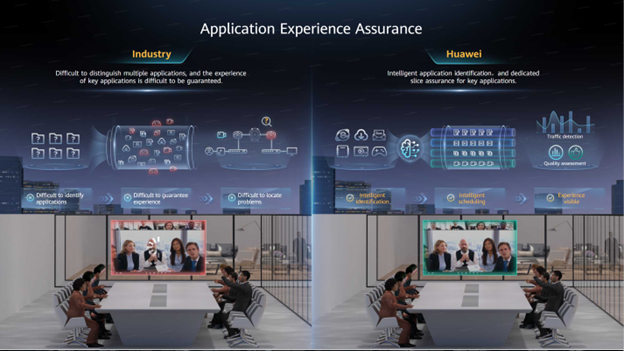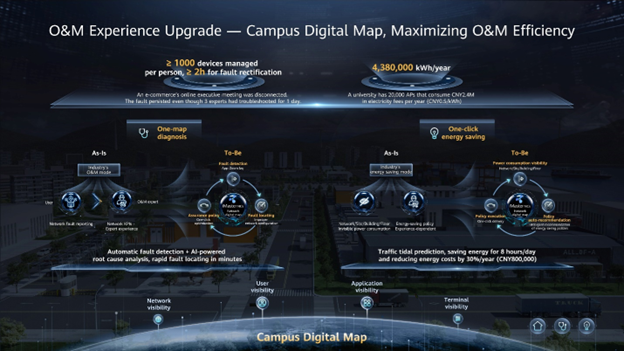- Honey, the Amazon humanoid delivery robot is here! (well, almost)
- Why I recommend this Linux distro to Windows 10 users who can't upgrade to 11
- The 7 features Google Chrome needs to compete with my favorite browsers
- #Infosec2025: Cybersecurity Lessons From Maersk’s Former CISO
- Google flexes AI muscle with Gemini 2.5 Pro updates - who doesn't love higher prompt limits?
High-Quality 10 Gbps CloudCampus. High-Quality must be included.

The global campus network market is quietly but steadily expanding. The first quarter of 2023 saw a 43.3% YoY increase in the enterprise segment of the worldwide wireless local area network (WLAN) market, achieving a market value of $2.8 billion. This strong growth was largely driven by the adoption of the latest industry standards Wi-Fi 6 and Wi-Fi 6E.
As WLAN systems continue to improve, networks must evolve in tandem beyond simply offering more connectivity. Campus network users are beginning to transition from basic connectivity needs towards an experience-centric focus, demanding high-quality networks along with a positive user experience.
Elevating the wireless experience
An experience-centric architecture is all about the end-user experience; as a result, Huawei has introduced the industry’s first all-scenario Wi-Fi 7 network. The new network offers higher performance, greater range, and 50% higher concurrency than standard Wi-Fi. Its upgraded bandwidth offers twice the performance of Wi-Fi 6E while enhanced user concurrency allows stable 4K streaming across up to 30 channels.
Wi-Fi 7 is already proven its use in the healthcare industry. In the hospital for instance, where every moment is critical, doctors can now stream videos and gigabyte-sized CT scans at up to 4.3Gbit/s from anywhere within the hospital campus—a significant upgrade from the previous practice of slowly downloading data over low-bandwidth wired networks on fixed terminals.
Another example is the use of the latest 3D imaging to help students study the structure of key organs. Before Wi-Fi 7, having more than five students concurrently logged in often resulted in frame freezing and vertigo. Now, as many as 30 medical students can log in together, studying the human body in ultra-high definition.
For networks that need higher levels of security such as public services and finance, Huawei Wi-Fi 7’s chip-level encryption technology maintains a bandwidth five times higher than others in the market, without post-encryption deterioration. Huawei’s Wi-Fi Shield keeps signals hidden to deny access and infiltration by other users, while Channel Isolation Anti-Eavesdropping capabilities provide security for individual users.
Infusing IoT into the campus network
As digitalisation becomes mainstream across campuses, Huawei has introduced innovative upgrades to leverage the increasing convergence of Wi-Fi and IoT. One of Europe’s supermarket operators, procured hundreds of thousand IoT access points (APs) with built-in IoT cards from Huawei, to manage tens of millions of electronic labels across its more than 10 thousand stores. By eliminating the need for onsite deployment, the retail slashed costs of up to EUR1200 per site, saving millions across the entire chain.
Huawei is also working on the next generation of IoT APs to support advanced technologies such as Near Link and edge computing containers. These will enable industrial robots, sensors, and controllers to achieve ten times as many connections and six times the data transmission rates of today’s systems, while reducing latency by 97% and doubling range with 60% lower power consumption rates than today’s systems.
A new application experience
Application experience is the second critical component of intelligent application identification. This can identify 6000 applications and enable dedication of fast lanes for key apps to ensure zero packet loss and frame freezing—while offering real-time app visualisation to allow problem identification within minutes.
Huawei

Huawei
The network experience and access of key personnel and critical enterprise tools can have an outsized impact on efficiency. To address this, Huawei has developed a VIP experience assurance solution utilising prioritisation and super frame pre-emption and per-packet power control technologies to prevent packet loss and frame freezing, ensuring VIP access and experience even during network congestion.
Raising the bar for O&M
Large campus networks can have tens of thousands of users and layers of complexity, maintained by only a handful of personnel. To effectively scale network operations and maintenance, Huawei has introduced a campus digital map. This comprises a comprehensive four-dimensional map of the network, users, and applications to enable quick fault detection and proactive troubleshooting. A user experience playback feature facilitates rapid fault source identification and offers troubleshooting suggestions. The system can also identify unusual access behaviour promptly, allowing fast action to prevent network disruptions.
Embracing sustainable campuses
In addition, with the network transformation from wired to wireless, the number of APs on the campus network increases exponentially.
We take education as an example. A school building with 20,000 APs has annual electricity fee of ¥2.4 million. But in such places, network is hardly being used at night: APs enabled around the clock means wasted power resources. Automatically recommending the optimal energy saving period for Aps based on the traffic tidal prediction can result in 30% reduced power consumption in typical scenarios, in turn improving power utilisation.
Some enterprises or universities deploy people to periodically turn on and off devices in the entire office or classroom; this manual process is both tedious and inefficient. Huawei campus digital map can analyse the network usage of each area in real time, use tidal algorithm to intelligently recommend energy-saving policies, and deliver the policies by one click.
This way, APs are switched off during off-peak hours, with only a few APs reserved for basic signal coverage. The APs are then automatically powered on during peak hours. In typical scenarios, the power consumption can be reduced by 30%.

Huawei
The Future of CloudCampus with Huawei
Huawei 10 Gbps CloudCampus, with its upgraded wireless, application, and O&M experiences, is at the forefront of the transition from a connectivity-centric to an experience-centric era.
Click here to learn how Huawei solutions can help intelligently transform your campus network.

